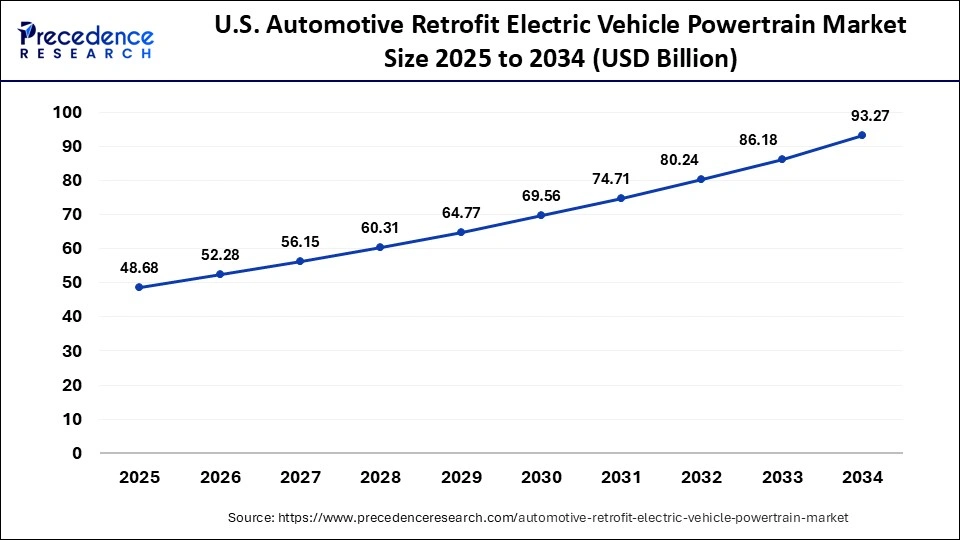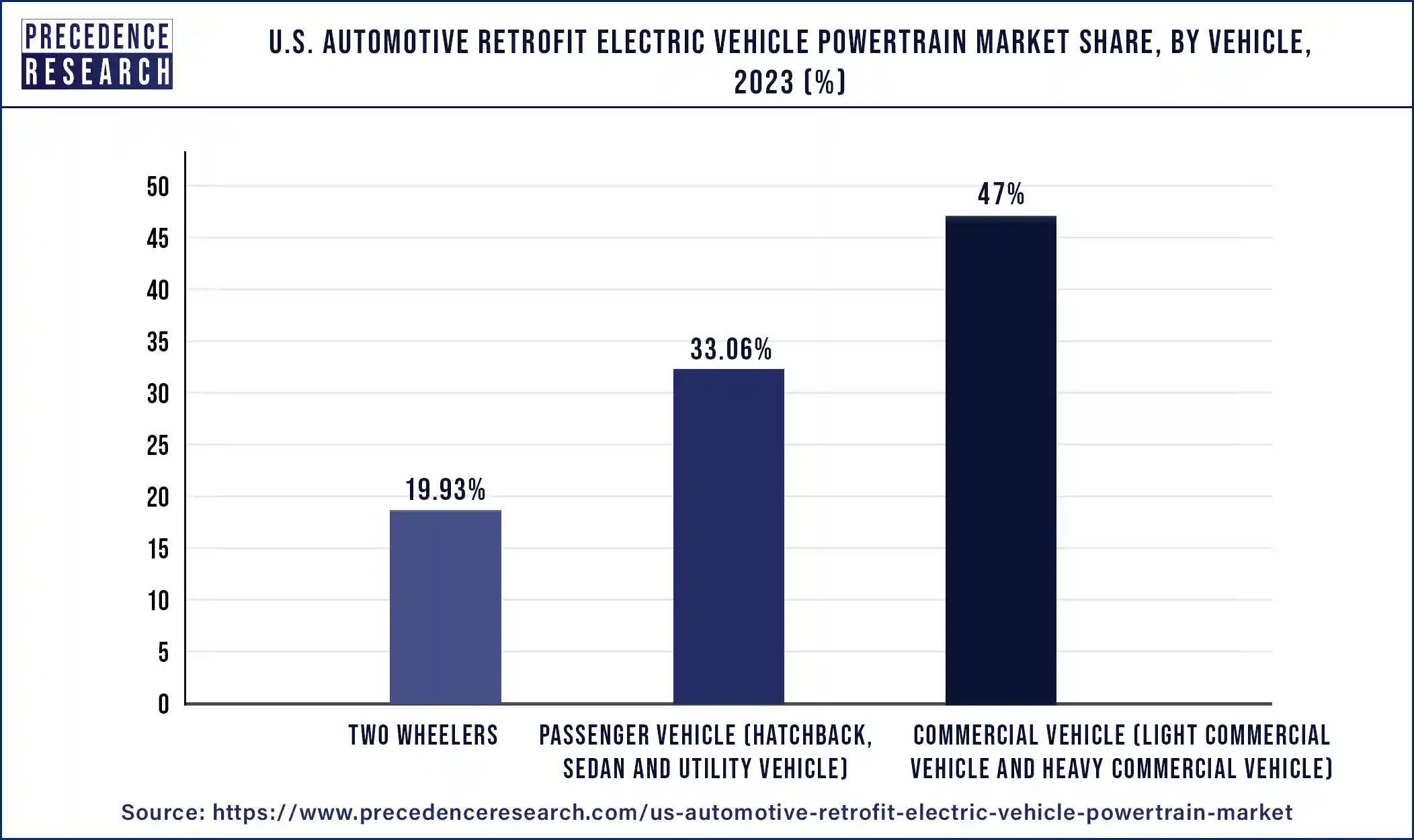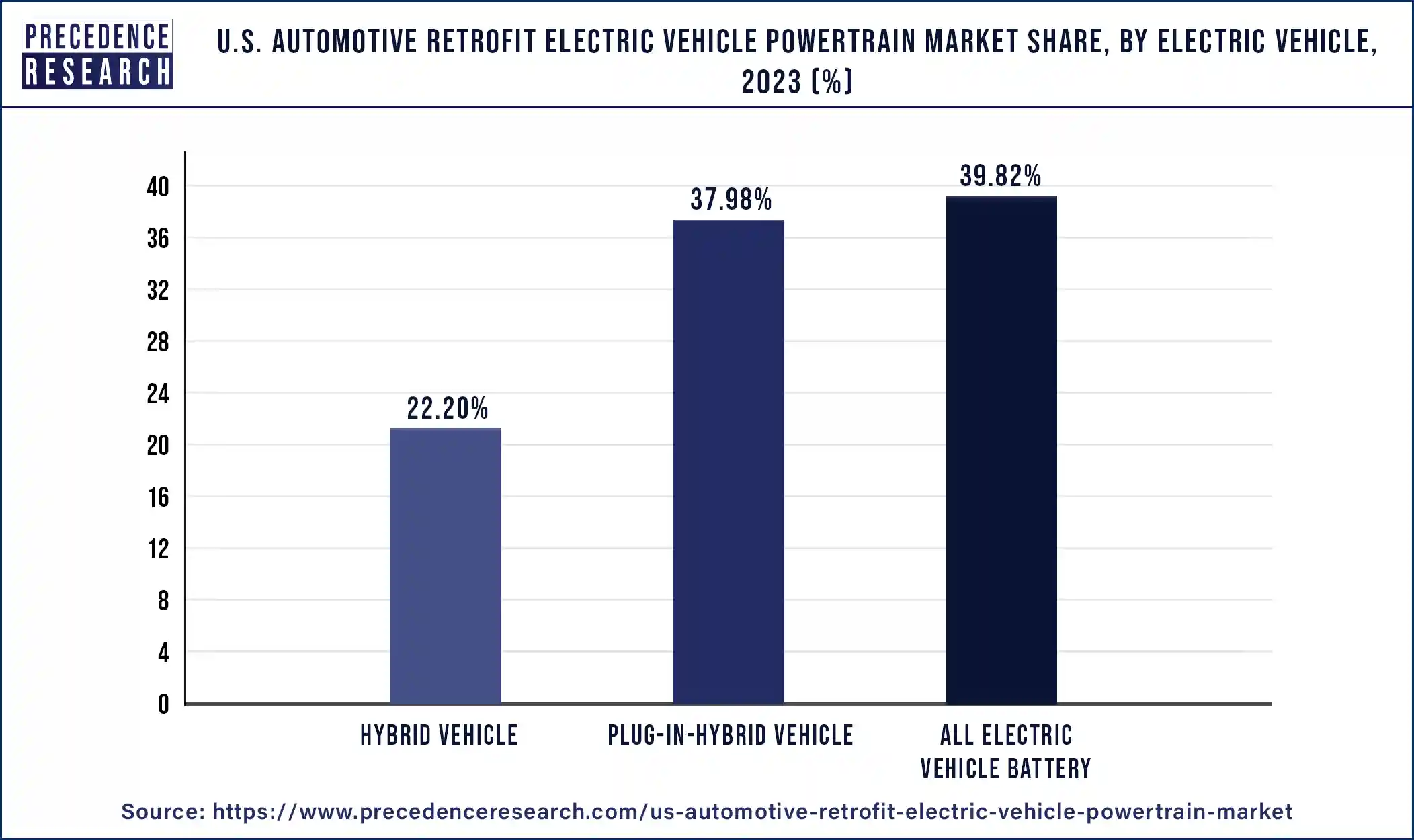December 2024
U.S. Automotive Retrofit Electric Vehicle Powertrain Market (By Component: Inclusive Conversion Kit, Electric Motor, Battery, Controller, Charger, Others; By Vehicle: Two Wheelers, Passenger vehicles, Commercial vehicle; By Electric Vehicle: All Electric Vehicle Battery, Plug-in-hybrid Vehicle, Hybrid Vehicle) - Regional Outlook and Forecast 2025 to 2034
The U.S. automotive retrofit electric vehicle powertrain market size was valued at USD 64.62 billion in 2023 and is anticipated to reach around USD 210.15 billion by 2033, growing at a CAGR of 12.51% from 2024 to 2033.

U.S. Automotive Retrofit Electric Vehicle Powertrain Market Overview
Automotive retrofit electric vehicle powertrains are integrated electric drivetrains typically installed on vintage or classic cars to turn them into electric vehicles and reduce emissions. Among other players, there are significant financial prospects for manufacturers, suppliers, and service providers in the retrofit electric vehicle powertrain industry. By investing in this industry, businesses can exploit the expanding market need for electric car conversion kits, parts, and services. This supports the shift to a low-carbon economy and encourages innovation, job development, and economic growth in the automotive sector.
In September 2022, XL Fleet Corp announced the acquisition of Spruce Power, the largest privately held owner and operator of residential rooftop solar systems in the US. In connection with the acquisition of Spruce Power, XL Fleet also unveiled its new corporate strategy to provide subscription-based solutions for rooftop solar and battery storage. EV charging, and other distributed energy resources.
U.S. Automotive Retrofit Electric Vehicle Powertrain Market Data and Statistics
| Report Coverage | Details |
| Growth Rate from 2024 to 2033 | CAGR of 12.51% |
| U.S. Automotive Retrofit Electric Vehicle Powertrain Market Size in 2023 | USD 64.62 Billion |
| U.S. Automotive Retrofit Electric Vehicle Powertrain Market Size in 2024 | USD 75.93 Billion |
| U.S. Automotive Retrofit Electric Vehicle Powertrain Market Size by 2033 | USD 210.15 Billion |
| Base Year | 2023 |
| Forecast Period | 2024 to 2033 |
| Segments Covered | By Component, By Vehicle, and By Electric Vehicle |
Drivers
Increasing R&D efforts in retrofittable electric vehicle powertrains
Increasing R&D efforts in developing new types of retrofittable electric vehicle powertrains is one of the major factors driving the growth of the U.S. automotive retrofit electric vehicle powertrain market. The retrofittable powertrains support the transition from conventional vehicles to electric vehicles. Furthermore, due to rising social issues like pollution and advancements in technology enablers like battery cell technologies, mobility is undergoing a sustainability transition and is precipitating a sharp shift in favor of EVs. In addition to this, internal combustion engine (ICE) to EV conversion is a potential alternative step to accelerate the transition to wider EV adoption. EV retrofitting can accelerate EV adoption, improve public acceptance of EVs, raise ICE vehicle resource use, and accelerate EV infrastructure development.
Growing fuel prices have driven the demand for U.S. retrofit electric vehicles
Prices have soared at historic rates nationwide, and pumped-up prices increased by half to a record-breaking $5 a gallon, causing rippling effects across a wide range of consumer products and contributing to the biggest national inflation. This has created a demand for an affordable alternative to fuel in the country and is facilitating the automotive retrofit electric vehicle powertrain market demand in the US. In addition, many Original Equipment Manufacturers (OEMs) provide alternative fuel and advanced technology automobiles, with different models, fuels, and systems. When gasoline engines are adapted to run on alternate fuels, these vehicles are classified as conversions.
Restraints
Lack of commercial charging outlets
Inadequate infrastructure for charging electric cars can lead to uncertainty about upcoming rules and incentives. Potential consumers may be reluctant to engage in retrofit conversions if lawmakers do not promise to increase the availability of charging infrastructure. They may worry that their vehicles will be subject to restrictions or constraints without a strong infrastructure for charging.
Potential alternatives for the market
A different alternative to electric retrofits is natural gas-powered automobiles. NGVs run on liquefied natural gas (LNG) or compressed natural gas (CNG), albeit less frequently than ICE or hybrid cars. They produce less pollution and greenhouse gases than conventional gasoline or diesel cars. Due to its cheaper fuel costs and the availability of natural gas infrastructure in some areas, NGVs may be preferred by some users, particularly those in commercial fleets.
Opportunity
Government initiatives to support the usage of EV
The adoption of EVs is also significantly influenced by government legislation. Automakers are encouraged by government policies, such as fuel economy standards and emission laws, to increase the production of electric vehicles or to retrofit current vehicles with electric powertrains to comply with legislation. Furthermore, several governments charge or prohibit cars with internal combustion engines to get people to convert to electric vehicles (EVs).
US EV Retrofit Market Revenue (US$ Bn), By Component
| By Component | 2019 | 2020 | 2021 | 2022 | 2023 |
| Inclusive Conversion Kit | 11.87 | 14.89 | 7.93 | 20.99 | 24.64 |
| Electric Motor​ | 5.70 | 7.14 | 8.58 | 10.03 | 11.74 |
| Battery​ $6.72 | 6.72 | 8.40 | 10.07 | 11.74 | 13.72 |
| Controller​ | 2.88 | 3.60 | 4.31 | 5.02 | 5.87 |
| Charger​ $0.83 | 0.83 | 1.04 | 1.24 | 1.44 | 1.67 |
| Others (Axle, Converter)​ | 3.50 | 4.35 | 5.19 | 6.01 | 6.98 |
The inclusive conversion kit segment dominated with a 38.12% share in the U.S. automotive retrofit electric vehicle powertrain market in 2023. Government laws to cut carbon emissions and growing environmental concerns have increased the demand for electric vehicles. For many people, though, the cost of a new electric vehicle may be prohibitive. Accessory conversion kits provide a compelling substitute, allowing people to convert their current gas-powered cars into electric ones. A wider range of customers are drawn to this accessibility, including those sentimentally tied to their current cars, budget-conscious buyers, and those who care about the environment.
The battery segment was the second largest with share of 21.23% in the U.S. automotive retrofit electric vehicle powertrain market in 2023. The electric vehicle ecosystem has accelerated innovation due to the growing competition among technological companies, battery suppliers, and automobile manufacturers. The battery segment of the automotive retrofit market is expected to increase further due to companies' ongoing efforts to produce more sophisticated and affordable battery solutions suited explicitly for retrofit applications.
The commercial vehicle segment dominated with a 47.00% share in the U.S. automotive retrofit electric vehicle powertrain market in 2023. Commercial vehicles, including delivery trucks, buses, and freight haulers, frequently travel long distances in stop-and-go traffic. Because of their high fuel consumption, these cars are excellent candidates for electrification to save operating expenses. Fleet operators are strongly motivated to adopt electric powertrains due to the potential for significant fuel savings over an extended period. Fleet electrification can be achieved with flexibility and scalability by retrofitting current commercial vehicles with electric drivetrains. Fleet owners can gradually electrify their whole lineup without needing to make a sizable upfront capital expenditure because of retrofit providers' ability to customize their services to accommodate a wide range of vehicle types, sizes, and uses.

The passenger vehicles segment is the fastest growing in the U.S. automotive retrofit electric vehicle powertrain market during the forecast period. The expansion of the passenger car market has been largely attributed to increased public awareness and education efforts stressing the advantages of electric vehicles, such as decreased greenhouse gas emissions, reduced air pollution, and energy economy. Customers are more likely to view electric vehicles as a competitive option than conventional gasoline-powered cars as they learn about their benefits.
The all-electric vehicle battery segment dominated with a share of 39.82% in the U.S. automotive retrofit electric vehicle powertrain market in 2023. Significant technological developments in recent years have increased the energy density, range, charging times, and overall performance of all-electric car batteries. These developments have increased consumer interest in all-electric cars and propelled the expansion of the retrofit industry. The initial cost of electric vehicles has gotten closer to that of conventional internal combustion engine vehicles as battery technology costs continue to drop and economies of scale are achieved through mass production. Customers can afford to choose electric vehicles because of their cheaper running expenses, which include maintenance and fuel.

The plug-in-hybrid vehicle segment is the fastest growing in the U.S. automotive retrofit electric vehicle powertrain market during the forecast period. Concerns about air pollution and climate change make customers more aware of their carbon footprint. To migrate towards cleaner mobility without the range anxiety associated with pure electric vehicles, plug-in hybrid vehicles offer a middle ground between conventional internal combustion engines and fully electric vehicles. A growing consciousness of the limited supply of fossil fuels and rising gasoline prices have stimulated customer demand for vehicles with higher fuel efficiency. Plug-in hybrids save fuel and lower total running expenses by enabling switching between electric and gasoline power.
Geographical trends for the U.S. automotive retrofit electric vehicle powertrain market
Both federal and state governments provide incentives such as tax credits, rebates, and grants to promote the use of electric vehicles (EVs) and the conversion of existing vehicles with electric powertrains. These subsidies assist in lowering the initial expenditures related to retrofitting and increase consumer and commercial accessibility to EV technology. Increasing the number of charging stations around the US encourages the use of electric vehicles, particularly EVs that have been modified. More people and companies are choosing to upgrade their vehicles as having access to charging stations makes driving electric vehicles more practical and convenient while reducing range anxiety.
Segments Covered in the Report
By Component
By Vehicle
By Electric Vehicle
For inquiries regarding discounts, bulk purchases, or customization requests, please contact us at sales@precedenceresearch.com
No cookie-cutter, only authentic analysis – take the 1st step to become a Precedence Research client
December 2024
September 2024
July 2024
January 2025